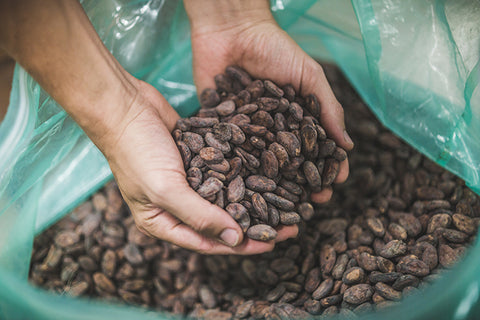Back in December, 2022, Consumer Reports published an investigation into heavy metals found in many popular chocolate brands. 23 of the 28 dark chocolate bars tested had concerning levels of lead and cadmium. Of course, the news spread quickly, and many people were left wondering if chocolate is even safe to eat.
This wasn’t the first time concerns were raised about heavy metals in chocolate.
In 2014, As You Sow’s environmental health team tested hundreds of chocolate bars and found that many contained lead and cadmium at levels that their scientists assessed were dangerous enough to require warnings to consumers under the Proposition 65 Toxic Enforcement Act in California.
There are reports of lead in candy and chocolate back from the 1990s, with lead in particular making its way into the finished goods through lead based ink. Of course, processes have changed significantly since then, but cadmium and lead are still present in chocolate.
How do cadmium and lead make their way into chocolate?

Cacao seeds undergoing fermentation in Peru
Regarding chocolate, cacao has a particular vulnerability to absorb heavy metals from both the soil and air. As a result, the concentration of lead and cadmium present in chocolate can differ depending on the location where the cacao was grown and how it was handled.
Cadmium and lead have distinct sources of contamination. Cadmium is assimilated by the cacao tree roots and accumulates in the fruit, whereas lead contamination arises at different stages of the cacao production process. Typically, the origin of lead in cacao is human-related, stemming from various activities such as burning diesel gas, burning plastic, using leaded paint, employing fertilizers, and others.
Since many cacao producers ferment their cacao seeds on the ground or near roadways, it is likely during this period that the cacao is contaminated with lead. And since many producers are paid the bare minimum for their cacao, there is no real incentive for them to change their process.
What are the limits of cadmium and lead in chocolate?

Fermented and dried cacao seeds at our facility in Toronto, ON
The Food and Drug Administration (federal agency in the USA) has set limits on the amount of lead and cadmium that is allowed in chocolate products. For lead, the limit is 0.1 parts per million (ppm) for all foods, including chocolate. For cadmium, the limit is 0.3 ppm for chocolate and 0.5 ppm for cocoa powder.
The Canadian Food Inspection Agency (CFIA) has stated the following in regards to lead
“All foods sold in Canada must comply with Section 4 of the Canadian Food and Drugs Act. In the case of lead, the Government of Canada recognizes that there can be multiple sources that account for the presence of lead in food. Whether from natural or man-made sources, all food industries are expected to minimize the presence of lead by any and all processes available to them. This is consistent with the ALARA (As Low As Reasonably Achievable) principle. Given the wide variety of processes, procedures and sources of raw materials, the means of implementing the ALARA principle will be company-specific.”
Does our cacao contain lead and cadmium?
The short answer is yes. But well within the safe daily limits. The reality is, all cacao contains lead and cadmium. Some sources of cacao have far more, as documented above by As We Sow, and others have far less.
Do not fret! We only use cacao that has been lab tested for heavy metals and pathogens. This test is done on a yearly basis from both of our sourcing partners Meridian Cacao and Uncommon Cacao.
If there are sources of cacao that contain high levels of heavy metals, we simply do not use them.
Heavy metals in chocolate can be a concern if it is not monitored and if there is no accountability. By choosing chocolate products that meet the guidelines set out by the government, varying your diet, and supporting sustainable practices, you can enjoy this treat without worry.

